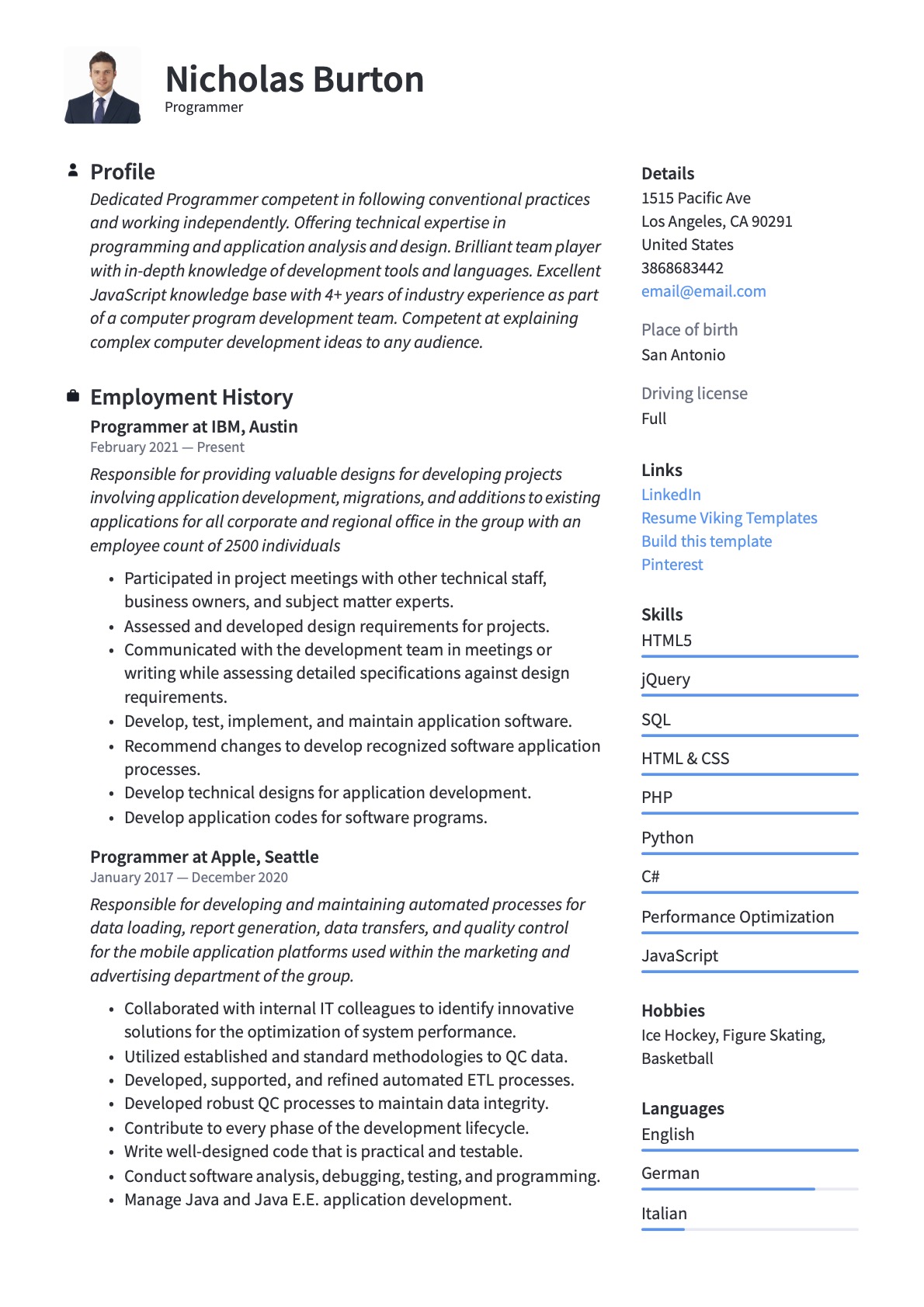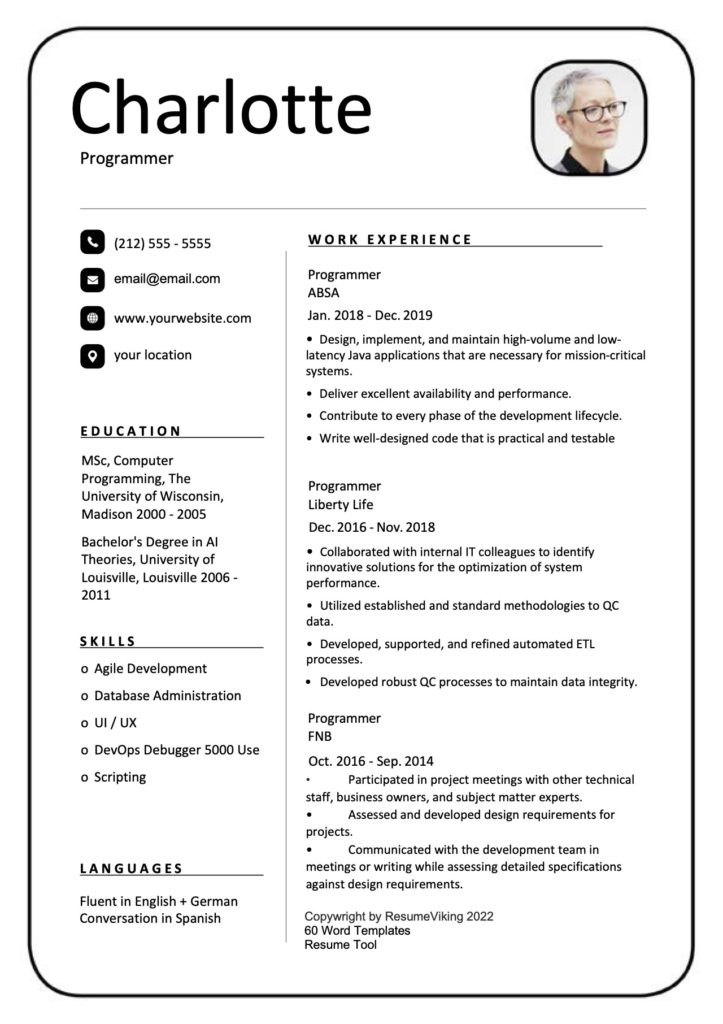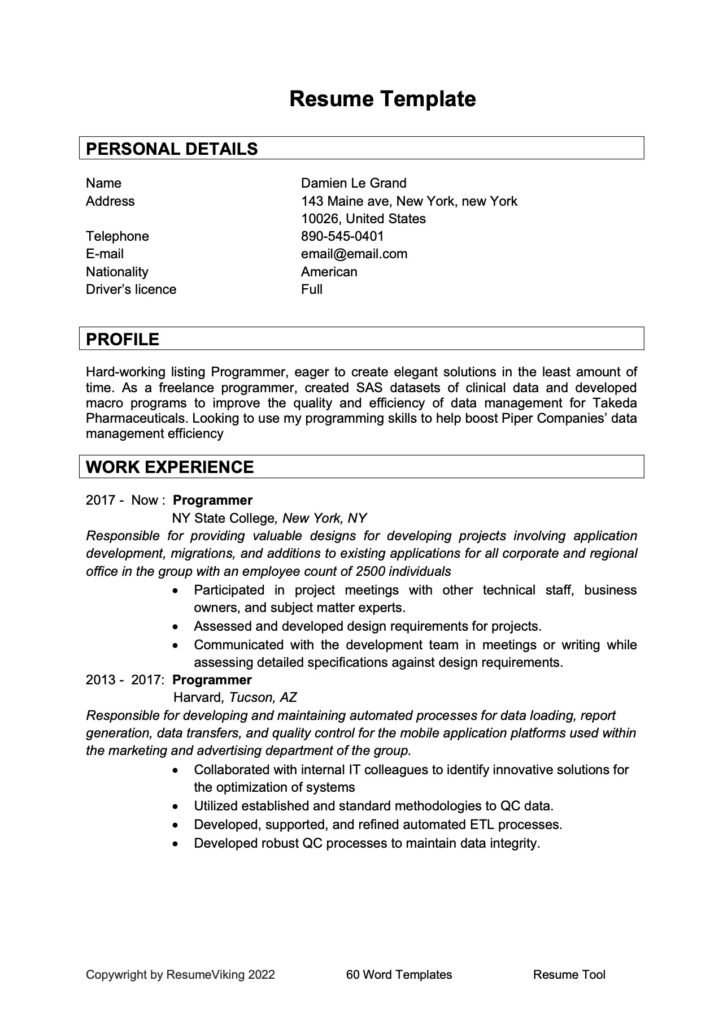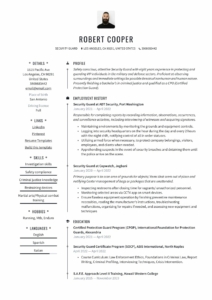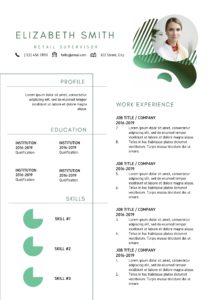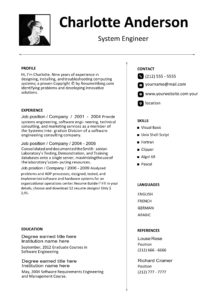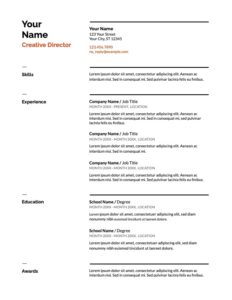If you are on the hunt for a new job as a Programmer, it is imperative that you look through a few well-written Programmer resume examples. This is a very competitive field, and you need to show more than simple programming and coding skills to land yourself an interview. That is what we are here for. Allow us to show you how to create an interview landing resume!
What you can read in this article
Programmer Resume Examples
(Free sample downloads are at the bottom of this page)
Programmer Resume Writing Guide
Resume Sections:
- 1. Contact information
- 2. Profile Summary
- 3. Employment History
- 4. Accomplishments
- 5. Education
- 6. Skill Section
- 7. Certification & Licensing
- 8. Extras: Languages/Awards/Publications/Volunteering/hobbies
- > Professional information
Also check out our other developer resume examples.
What to Highlight in a Programmer Resume
The beauty of programming is that it can be done anywhere globally, and many companies outsource their programmers from countries where there are lower wages. It is predicted that employment for programmers is likely to shrink by 7% over the next ten years. Do not stress, in any case. There are still major corporations that require on-site programmers. This, however, means that there will be an increase in the amount of competition. The best way to fight the competition is by writing a resume a stands out from everyone else, and that is exactly what this guide will show you:
Firstly, you need to show that you can be an effective team player. It is highly likely that you will be placed in a team and asked to either complete tasks together in smaller groups or individually in a large group.
Secondly, whether you are an entry-level, mid-level, or experience Programmer, there are specific tasks that you have been required to do in previous positions. When listing your experience, ensure that you are specific about the particular responsibilities and duties you were given, allowing the reader to ascertain your competency level.
This is very important information and needs to be easy for the reader to find. Ensure that you highlight this information in your experience section.
Lastly, you need to describe your experience within this industry. Whether it is in a small start-up company, or a huge multinational firm, Programmers will always be needed to test, develop, and monitor applications and software. Use the SIC codes on the U.S. Bureau of Labor website to identify the right categories you need to list.
Due to the ranging roles and duties of Programmers, we have listed several usual tasks you may be required to do:
- Program Architecture – Project stakeholders, recognize the complete vision of what must be accomplished, and they require a programmer's skills to finish their project.
- Development – Programmers begin by writing code that is needed for a complete program. It is a step-by-step process where sections of code called “features” are created to test. This allows Programmers to check for any errors in that section of code.
- Testing – Testing and debugging processes occur once the features are finished. This guarantees they will all work as intended.
- Deployment – Here, brand-new code is applied to a working environment where it must function correctly. If there are any changes, they must be done within a test environment and then deployed again once the changes have been made.
- Maintain Systems and Optimize – Once the program is complete, your work is definitely not finished. Programmers are required to maintain all working systems and recognize any opportunities where the system can be upgraded.
1. Contact information
- First & Last Name
- Physical Address
- LinkedIn / Portfolio
2. Career Profile/Summary & Examples
The role of your career summary is that of an introduction. It is a short paragraph between 5-6 lines in length that provides a quick snapshot of who you are and what you have to offer.
This is the first section that a hiring manager will read, which means it needs to be well written and should only reflect the most important information. Use the job description to identify the most important skills, qualities, and achievements the employer is looking for, and tailor your career summary/objective to reflect them.
We recommend that you use the specific keywords from the job description to create a sentence that highlights any of your exceptional qualities.
Lastly, finish off your career summary with a short sentence highlighting your most impressive educational qualifications or certifications.
If you are unsure whether to choose a career summary or objective, here is how to decide:
- A resume summary should be utilized by someone who has an extensive amount of work experience and needs to condense it. Examples of these types of people include Senior Software Programmers, C Programmers, Python Programmers, C++ programmers, and previous managers or executives.
- A resume objective is for more entry-level Computer Programmers or self-taught programmers with limited work experience. Here the focus should be on the skills that you have that will allow you to be successful if you are hired.
Examples:
Programmer Summary 1
“Dedicated Programmer competent in following conventional practices and working independently. Offering technical expertise in programming and application analysis and design. Brilliant team player with in-depth knowledge of development tools and languages. Excellent JavaScript knowledge base with 6+ years of industry experience as part of a computer program development team. Competent at explaining complex computer development ideas to any audience.”
Programmer Summary 2
“Proficient Programmer with 3+ years of experience in full SDLC creating dynamic web applications. Updates functionality founded on customer desires to guarantee an outstanding user experience. Other tenures include developing websites, applications, and intricate programs while at University. Competent in Oracle, Tomcat Apache, MySQL, PL/SQL, Ajax V.B., JavaScript, ASP, CSS, and HTML.”
Programmer Summary 3
“Experienced and well-organized computer science graduate with a B.S. from UCLA (GPA 3.8). Enthusiastic about joining Two Oceans as a junior Programmer to design game-changing e-commerce solutions. Established a custom-made e-commerce cart module on RESTful. Completed a 6-month Java development internship experience at Oracle.”
Programmer Summary 4
“Hard-working listing Programmer, eager to create elegant solutions in the least amount of time. As a freelance programmer, created SAS datasets of clinical data and developed macro programs to improve the quality and efficiency of data management for Takeda Pharmaceuticals. Looking to use my programming skills to help boost Piper Companies’ data management efficiency.”
3. Employment History
In most cases, employers expect their Programmers to do more than simple computer programming. You will likely be asked to partake in whole software development or to implement different technologies to achieve business goals. This is intricate work, but your resume needs to be the opposite.
The best resumes are clear and concise, which can be achieved by using specific formats to list your experience.
Remember, recruiters and hiring managers do not spend hours of their time reading meticulously through every resume they receive. In actuality, they simply scan your resume looking for information that will catch their eye and interest them enough to want to read more. Y
ou, therefore, need to ensure that your most impressive information is an easy read and captures the reader’s attention.
One of the best ways to do this in your experience section is by listing your employment history in reverse chronological order. This allows for your most recent and most impressive work experience to be read first.
Now that you know how to list your information effectively, it is time to add some extra information.
Every job title you mention needs to be accompanied by 5-6 bullet points highlighting the duties and responsibilities you were given.
Back these statements up with hard numbers and percentages that show you were an invaluable asset to the company.
Do not forget to read through the job description to outline the skills and qualities the employer is looking for. Once you have done this, you can integrate these keywords into your statements.
Examples
Programmer at IBM
(Jan 2011 – Current)
Responsible for providing valuable designs for developing projects involving application development, migrations, and additions to existing applications for all corporate and regional office in the group with an employee count of 2500 individuals
- Participated in project meetings with other technical staff, business owners, and subject-matter experts.
- Assessed and developed design requirements for projects.
- Communicated with the development team in meetings or writing while assessing detailed specifications against design requirements.
Programmer at Apple
(Jan 2008 – Feb 2011)
Responsible for developing and maintaining automated processes for data loading, report generation, data transfers, and quality control for the mobile application platforms used within the marketing and advertising department of the group.
- Collaborated with internal IT colleagues to identify innovative solutions for the optimization of system performance.
- Utilized established and standard methodologies to QC data.
- Developed, supported, and refined automated ETL processes.
- Developed robust QC processes to maintain data integrity.
Job Descriptions Examples
Below we have provided a list of crucial duties that Programmers will likely have to do:
A Programmer may:
- Design, implement, and maintain high-volume and low-latency Java applications that are necessary for mission-critical systems.
- Deliver excellent availability and performance.
- Contribute to every phase of the development lifecycle.
- Write well-designed code that is practical and testable.
- Conduct software analysis, debugging, testing, and programming.
- Manage Java and Java E.E. application development.
- Ensure that designs conform with stipulations.
- Prepare and produce for the release of the software.
- Transform any requirements into stipulations.
- Aim for constant improvement.
- Investigate options and new technology.
- Present for architectural reviews.
- Design, implement, and maintaining java application phases.
- Take part in architectural development and software activities.
- Identify production and non-production application issues.
- Develop, test, implement, and maintain application software.
- Recommend changes to develop recognized java application processes.
- Develop technical designs for application development.
- Develop application codes for java programs.
- Perform inclusive analysis and design for program changes, gaining, and transferring data of application changes.
- Review and prepare documents. Write up design documents for SRS and SDD.
- Define development tasks and provide time estimates to assist in scheduling.
- Assign and coordinate other employee’s tasks.
- Monitor progress against task estimates to deliver status.
- Act as a focal point to provide department project activities and status communication.
- Apply application-specific technical skills to produce deliverables autonomously. Examples include program changes, specifications, unit test scripts, and documentation.
- Acquire and utilize more in-depth business understanding to support applications.
- Recognize code, process, and typical inefficiencies to make recommendations for improvement if required.
- Perform unit test plans to guarantee all code changes meet stipulations.
How to Write a Programmer Resume with No Experience?
Some really good news is that programming projects are never hard to find and will often only take you a couple of days to complete. These will add much-needed relevant job experience to your resume. Below are a few coding project ideas:
- Freelance projects.
- Post your code on GitHub.
- Contribute to open source and freeware initiatives.
- Participate in Hackathons.
4. Accomplishments
Your accomplishments section is where you can take your resume to the next level. Here you can include all of your most admirable achievements that showoff your ability to be a successful programmer worthy of being employed.
There are, however, a few things to keep in mind when listing your accomplishments.
Firstly, keep in mind that the person reading your resume may not be as tech-savvy as you are and will not be able to understand code. It would help if you wrote your achievements to easily make sense of any Tom, Dick, and Harry.
Secondly, you need to prove every statement you make. Quantification is key.
Resume Quantification
Proving your achievement statements is crucial; otherwise, the employer has nothing to measure you against. Adding quantifiable information such as percentages, rankings, scores, dollar values, scopes, and metrics will significantly improve your resume's quality.
First, take a look at what not to do:
- Accomplished a decrease in the applications' memory consumption by removing duplicate strings using Garbage Collection Logs analysis and refactoring the code.
- Discovered and enhanced code inefficiencies, leading to an increase in the stability of the application.
- Created SOP, significantly reducing the analyst off-hours worked.
- Directed extensive review of many technical directives. Verified component applicability and incorporation status and ensured all aircraft and associated equipment were maintained using the most updated configuration.
Now, informative quantified examples:
- Accomplished a 39% decrease in the applications' memory consumption by removing duplicate strings using Garbage Collection Logs analysis and refactoring the code.
- Discovered and enhanced code inefficiencies, leading to a 47% increase in application stability.
- Created SOP, resulting in a 50% reduction of analyst off-hours.
- Directs extensive review of over 2,450 technical directives. Verified component applicability and incorporation status and ensured all aircraft and associated equipment were maintained using the most updated configuration.
5. Education Section
This may come as a relief, but your education is not always an employer’s main focus, and we recommend that you situate your experience section above your education section.
Be this as it may, your education section is still important and should not be neglected. Typically, you are required to have achieved a bachelor’s degree at a minimum, but if you have obtained higher qualifications, ensure that they are listed first. You want the reader to focus on the most impressive information.
When listing your educational information, simply begin with your graduation date, the name of the qualification, the name of the institution where you obtained the qualification, and lastly, the name of the city and abbreviated state name.
Follow the same format for your certifications and industry licenses.
Remember to include any qualification you are in the process of completing.
In some cases, programmers are self-taught and may have a degree in an unrelated field. This is perfectly fine, simply include both the unrelated degree and the online courses you completed.
*Pro Tip: If you have relevant work experience, do not include your GPA unless the job description specifically asks for it.
Examples of a Programmer resume regarding education and credentials:
2020 – Master’s in Electronic computer science, Washington University in St. Louis, St. Louis, MO.
Relevant Courses: Compilers and operating systems, systems and architecture, fundamentals of computer science, data structures, information theory, and web applications and databases.
2016 – Bachelor of Science in Computer Programming, Harvard University, Boston, MA.
2013 – Certified JavaScript, HTML5, and Microsoft; Computer Learning Center, Boston, MA
2012 – Project Management Professional Certification – PMP Global, Online
6. Skills
In this field, your technical skills arevery important; however, you need to highlight that you have effective soft skills as well.
These two sets of skills allow employers to gauge if you will be a meaningful addition to their company.
Before you start listing your skills, you need to read through the job description one more time to identify the specific skills and qualities the employer is looking for.
You may have a countless number of technical skills to offer, but if you list skills that are not relevant to the job you are applying for, the reader will become uninterested.
Furthermore, hiring managers expect to see that you have interpersonal skills that allow you to communicate effectively and work well with fellow employees.
The best way to list your hard and soft skills is by using a skills matrix.
Create one for your technical skills and one for your soft skills. Remember to include a competency table for your technical skills.
Technical Skills Matrix
| Competency | Expert Level 1-Novice, 2-Intermediate, 3-Expert |
|---|---|
| JSP | Level 2 |
| Relational databases | Level 1 |
| Software design and architecture | Level 3 |
| J2EE framework | Level 3 |
| Object-oriented analysis and design | Level 1 |
| Java-based web services | Level 2 |
| Enterprise java beans | Level 2 |
| XML | Level 1 |
| X query, XSL | Level 3 |
| Test-driven development | Level 3 |
| SQL and ORM | Level 3 |
| Microservices | Level 2 |
| DevOps tools (Jenkins, Docker) | Level 1 |
| Spring framework | Level 3 |
| Junit and Mockito | Level 2 |
| Angular | Level 3 |
| JVM Internals | Level 3 |
| Design patterns | Level 2 |
| Kotlin | Level 1 |
| React | Level 2 |
| Learn APIs and Libraries | Level 3 |
| Concurrency | Level 3 |
Interpersonal Traits Matrix
| Organization | Facilitation | Flexible |
| Team Player | Attention to detail | Cooperative |
| Written Communication | Time Management | Analytical Thinking |
| Verbal Communication | Punctual | Initiative |
| Reliable | Meticulous | Dependable |
| Prioritization | Sound Judgement | Stress Tolerance |
| Trustworthy | Creative Problem Solving | Persistent |
| Cooperative | Adaptable | Unconventional |
| Task Orientated | Analytical | Independent |
7. Qualifications & Certifications associated with Programmers
| BSc Computer programming | J Certified Scrum Master | Sun Certified Java programmer |
| Oracle certified java programmer | Salesforce.com certified administrator | Oracle certified professional |
| SCJP | Ava SE 6 programmer | Sun certified web component developer |
| PMP | Certified Scrum Master (CSM) | Apache spark developer certification- HDPCD |
| Spring professional certifications | Microsoft azure solutions certification | Project management professional certification |
Extra Sections for Programmer Resumes
One of the unfortunate problems with most Programmer resumes is that they all look almost identical.
A great way to work around this, and stand out from other applicants, is by creating an optional extras section. You can include further information about any professional certifications you have obtained, or volunteer work you have provided.
Other ideas include:
- Providing a link to an online resume platform such as LinkedIn.
- Including a link to your social media platforms such as GitHub.The reader can explore the other project work that you may not have included in your resume.
- Hobbies and interests are a smart way to showcase the employer that you are human and gauge what type of person you are.
- Any guest posts you have written for an industry blog.
- Any additional online courses, conferences, or hackathons you have attended.
Programmer Word Resume Download
Download Programmer Resume Examples
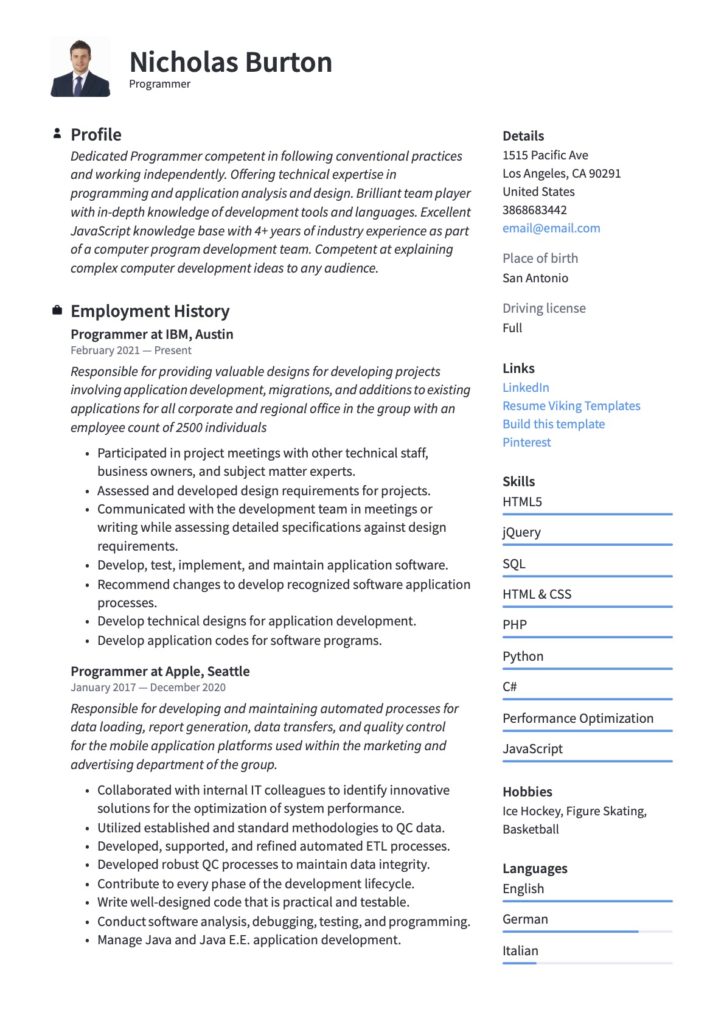
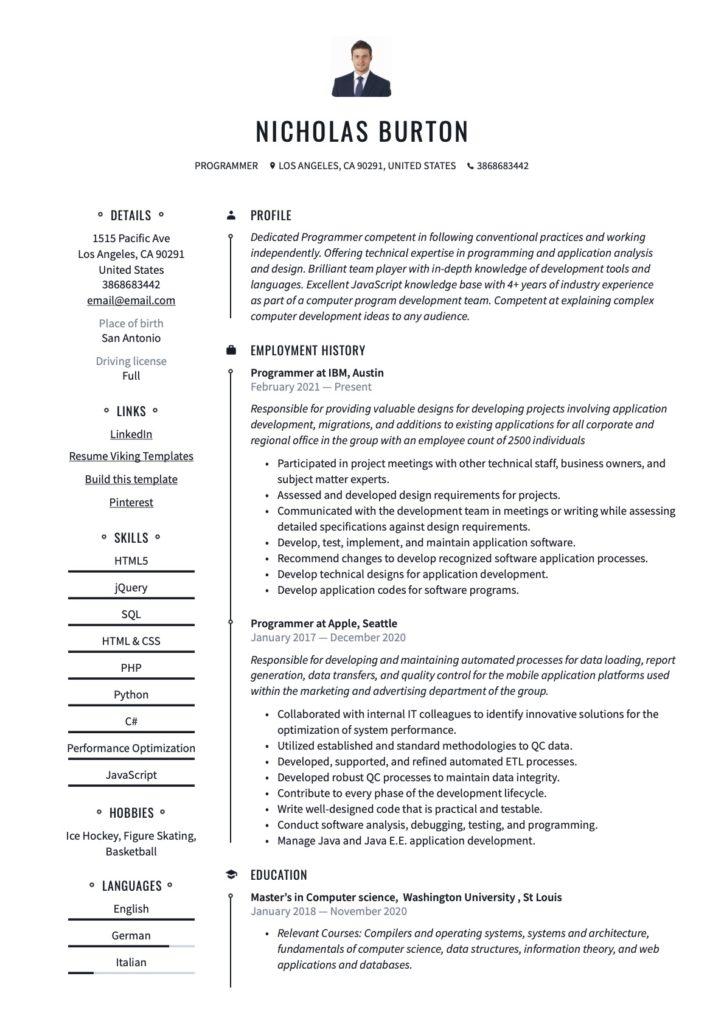
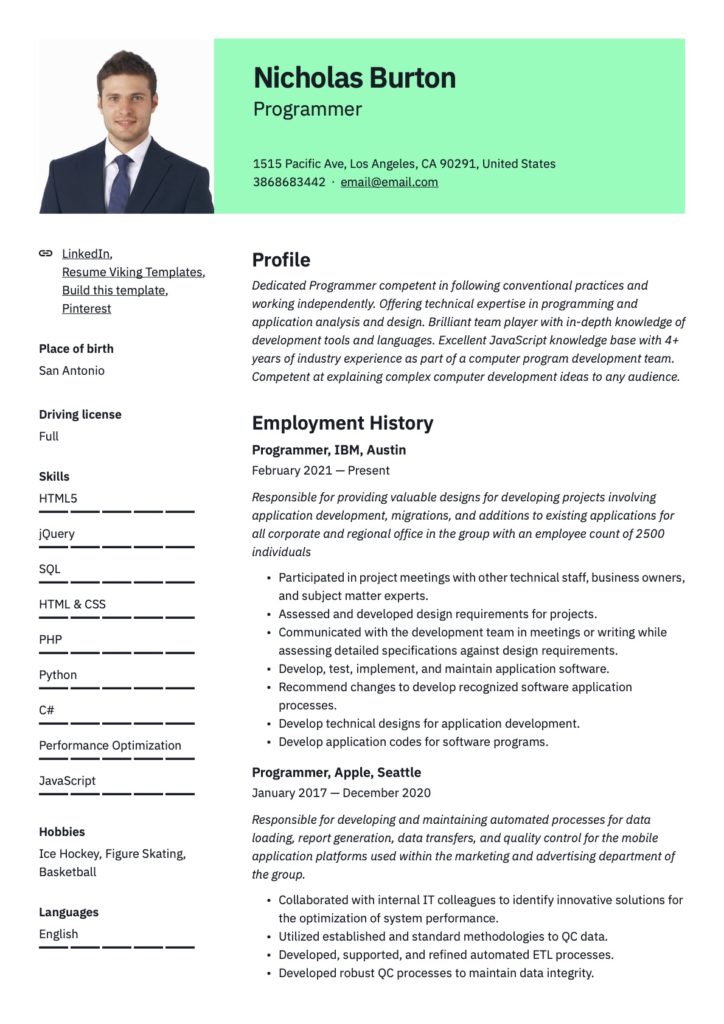
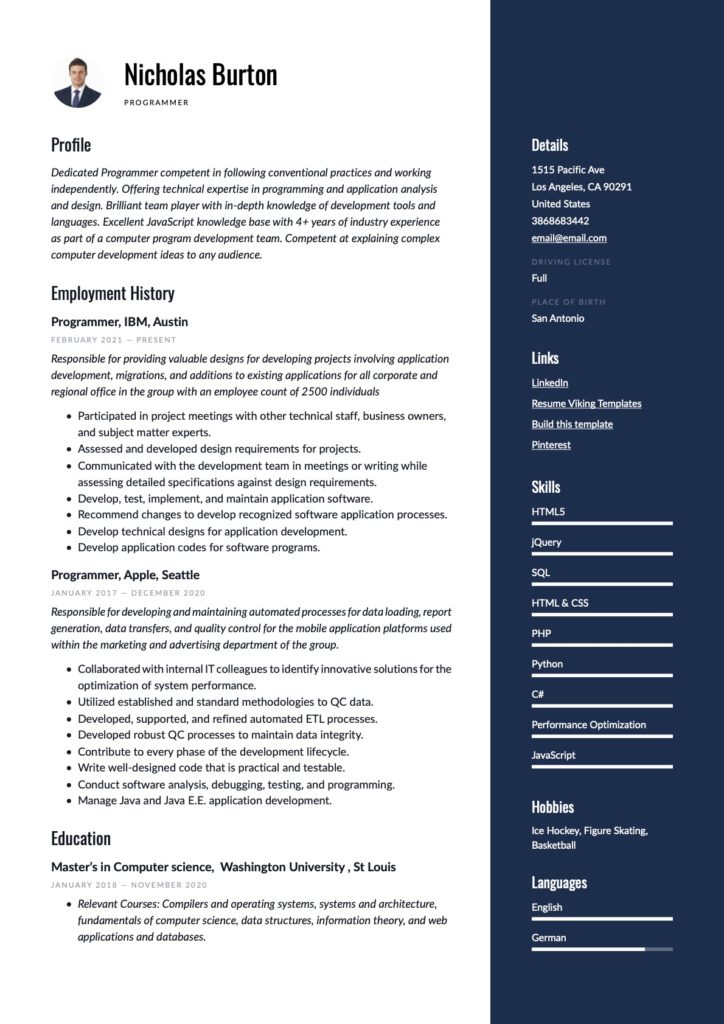
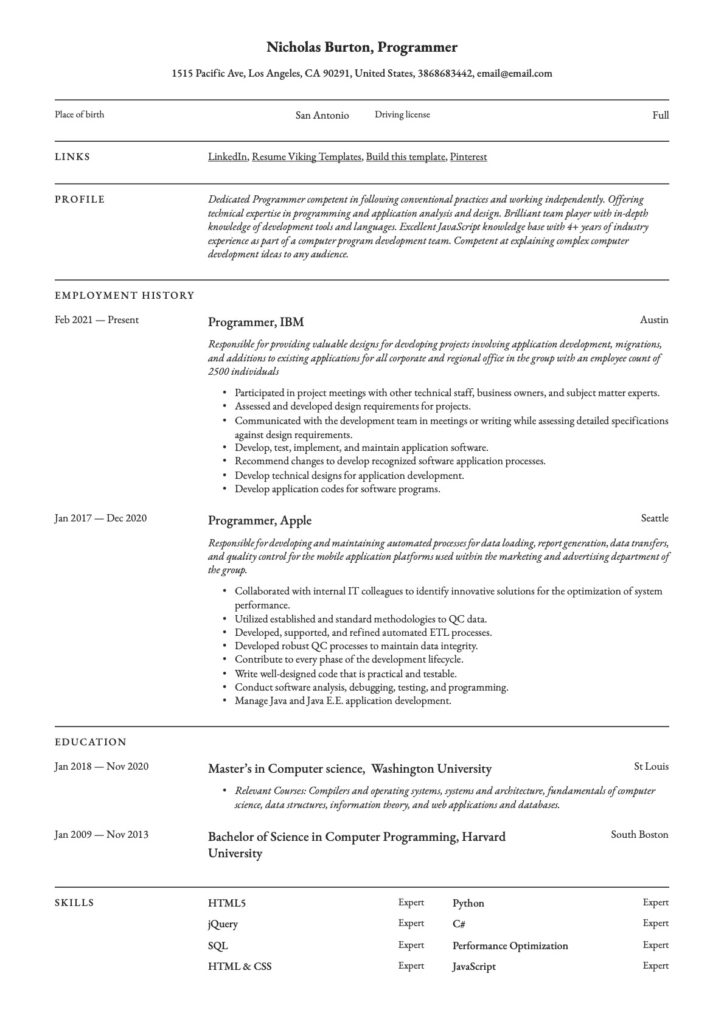
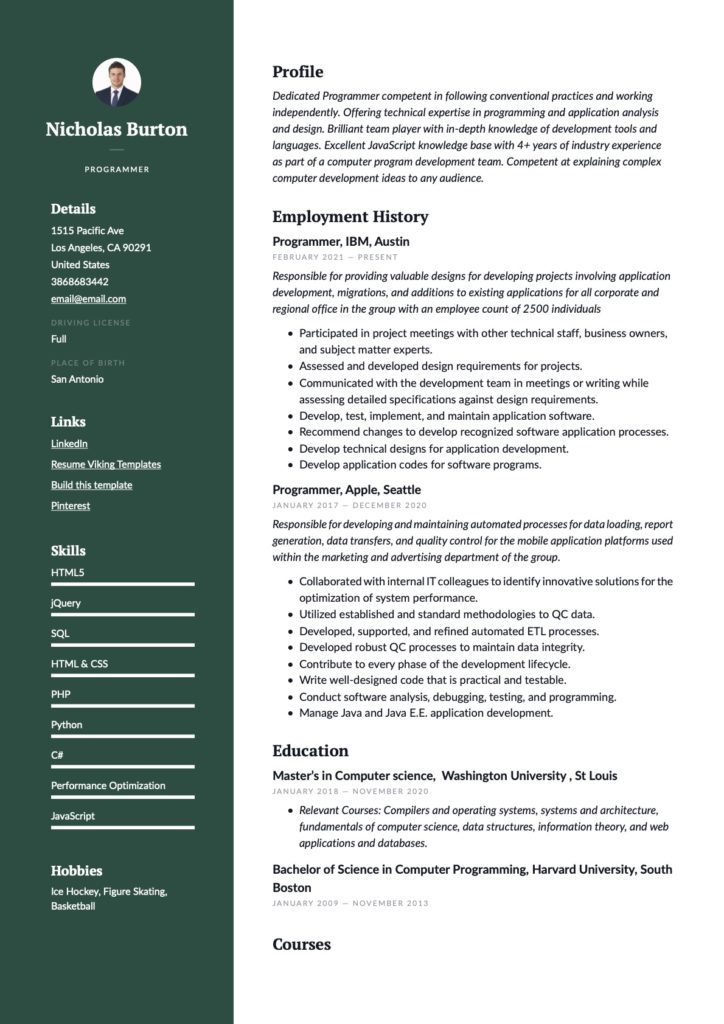
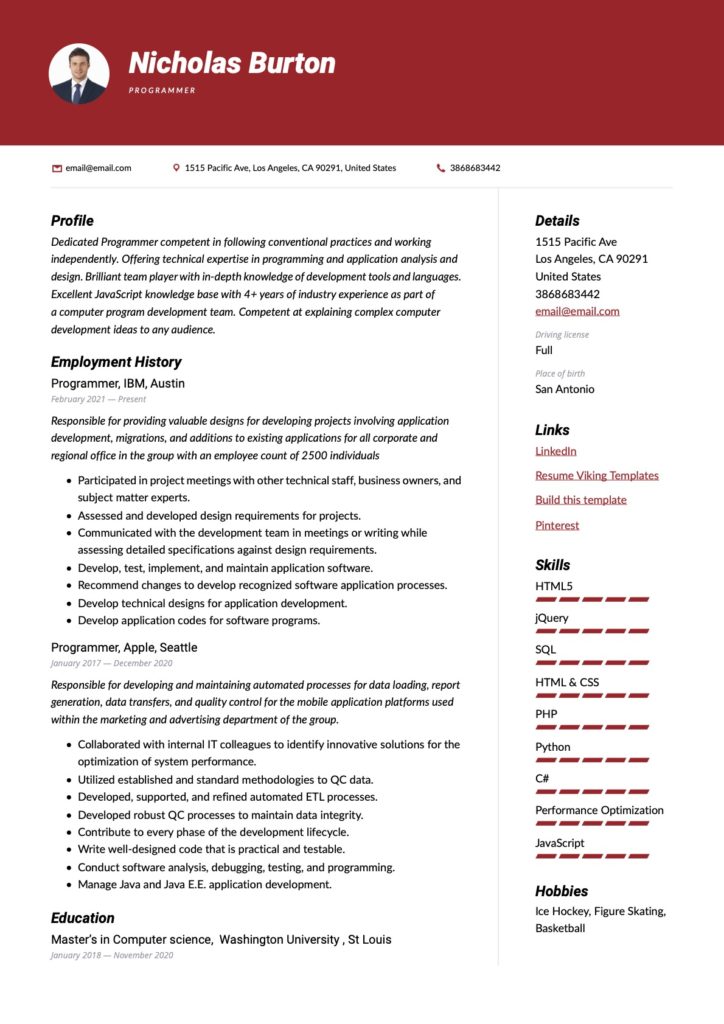
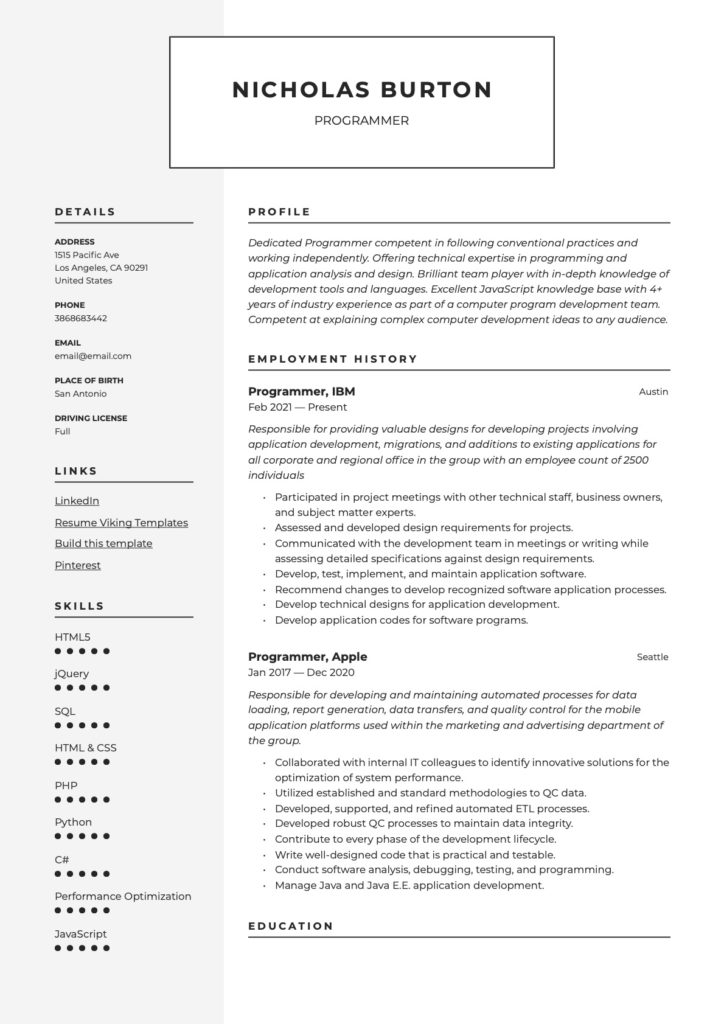
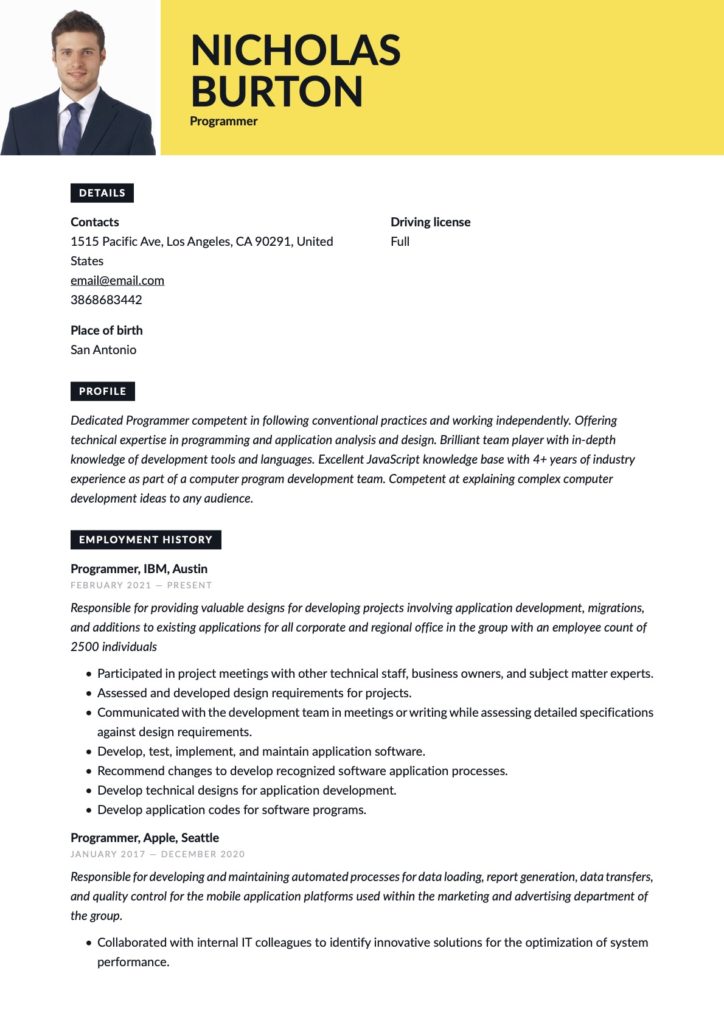
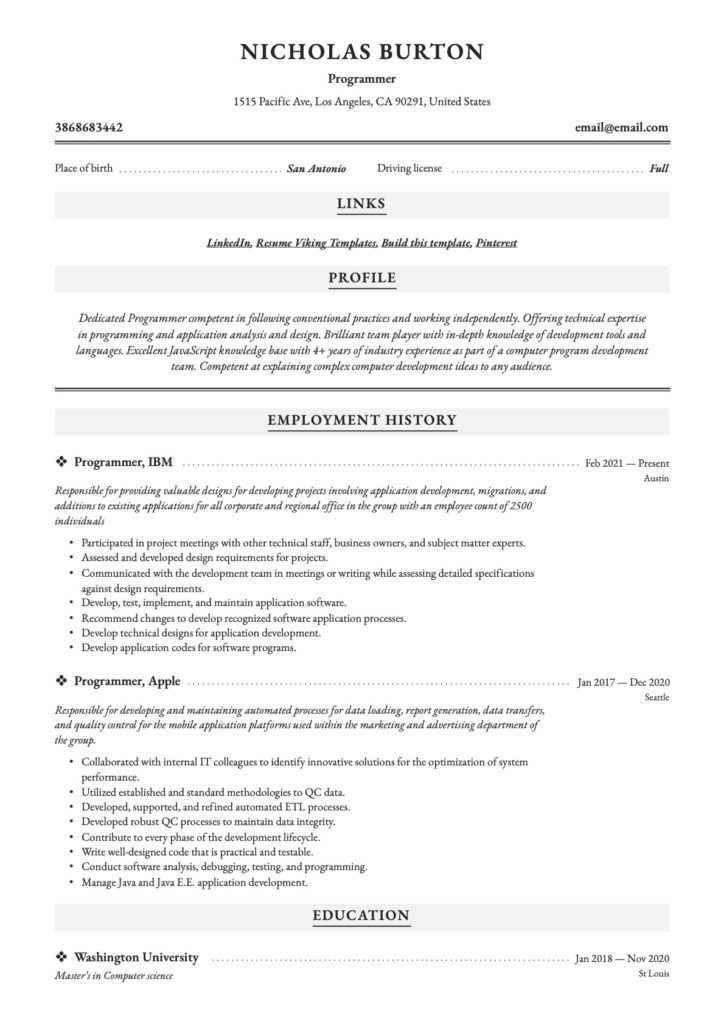
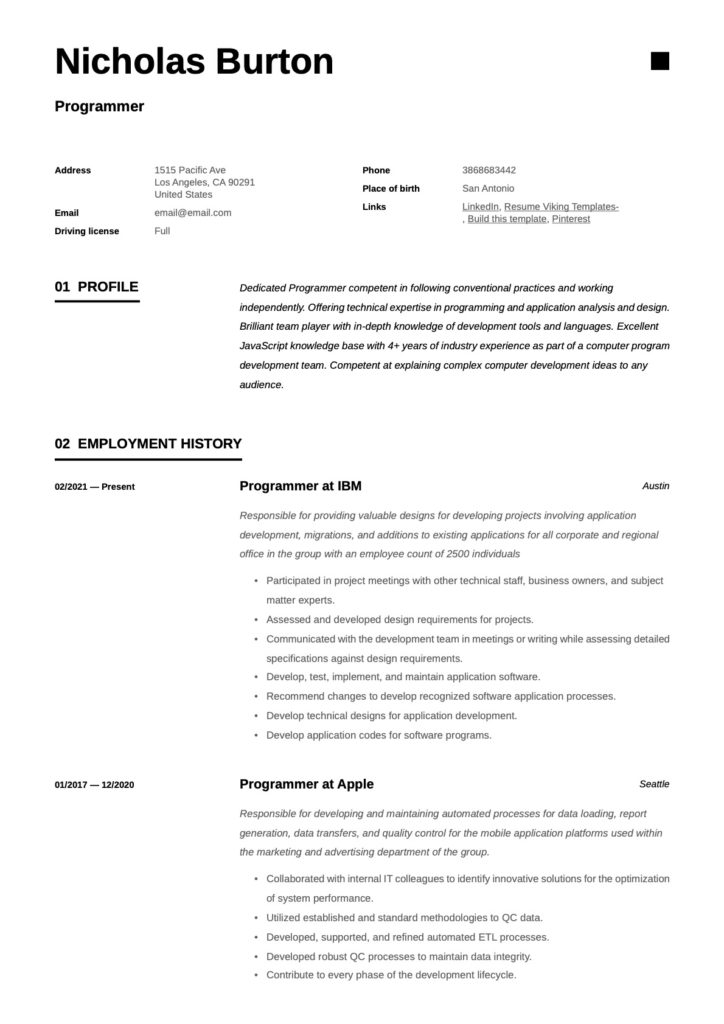
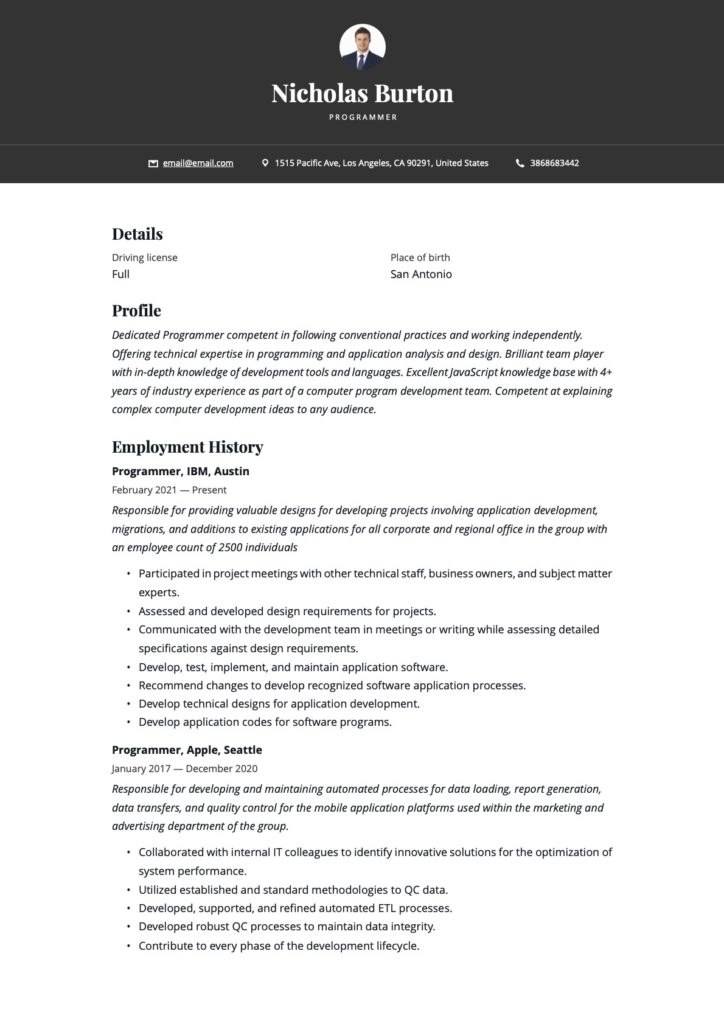
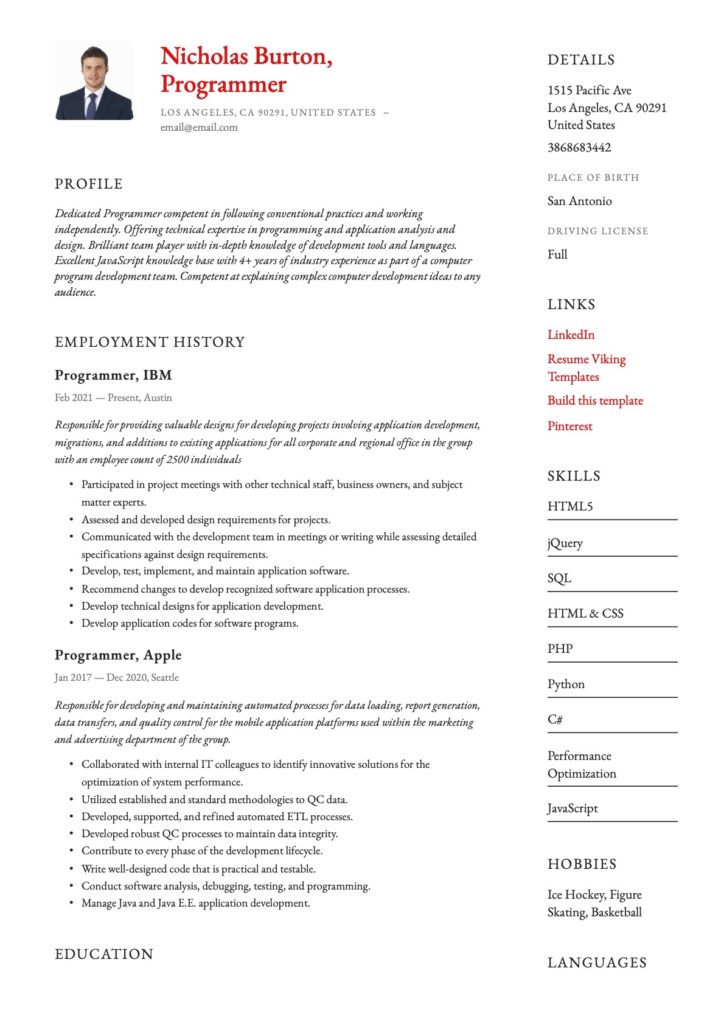
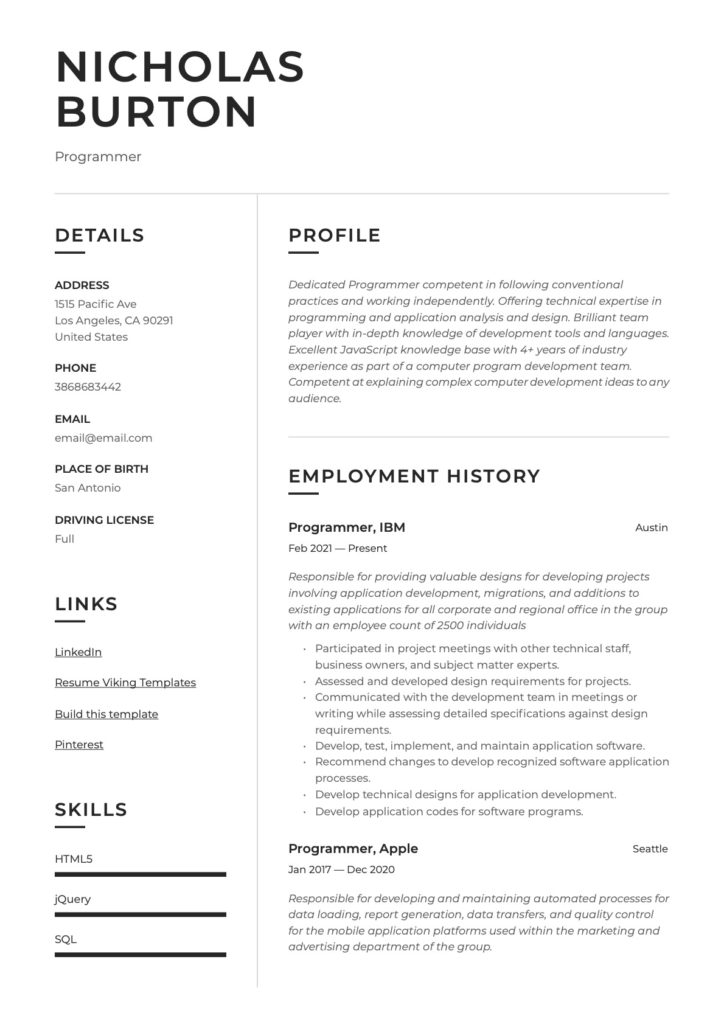
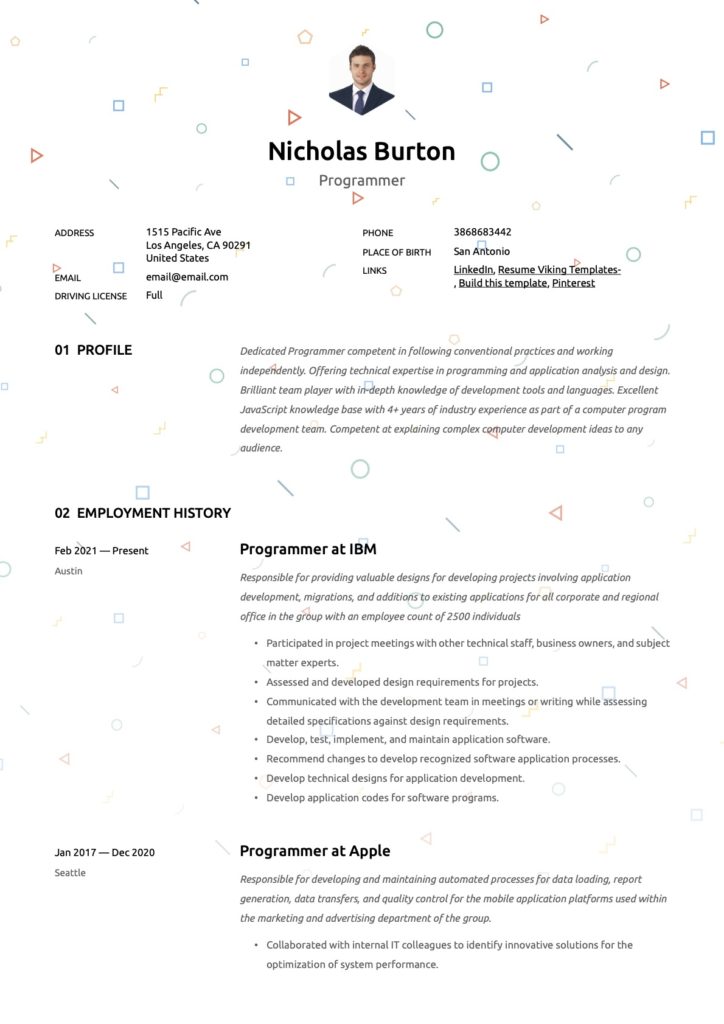
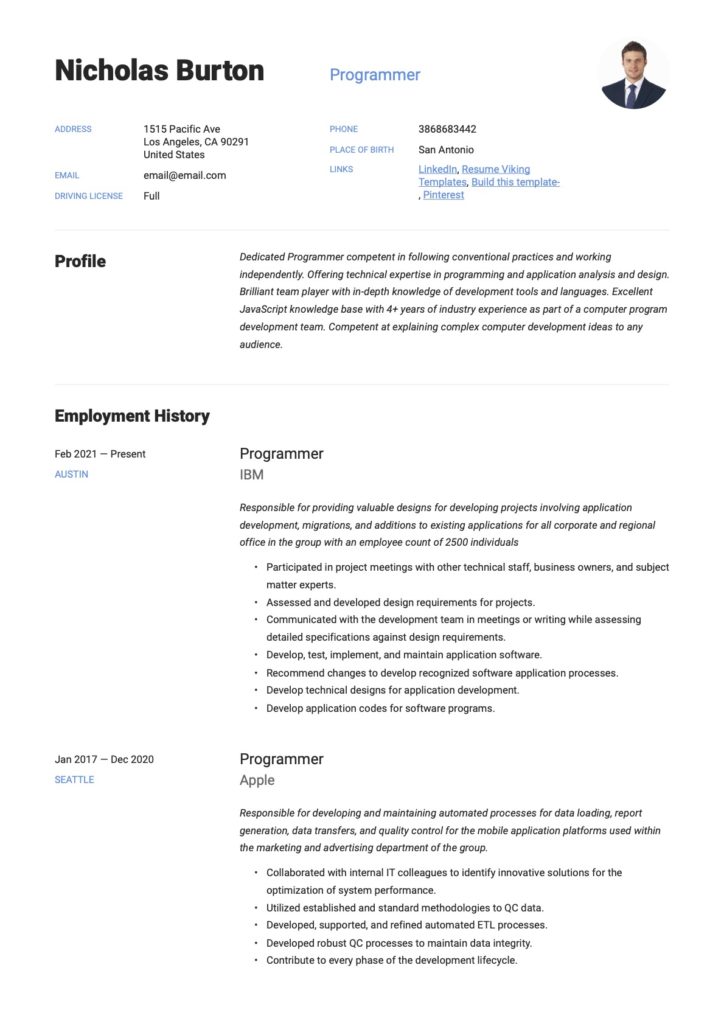
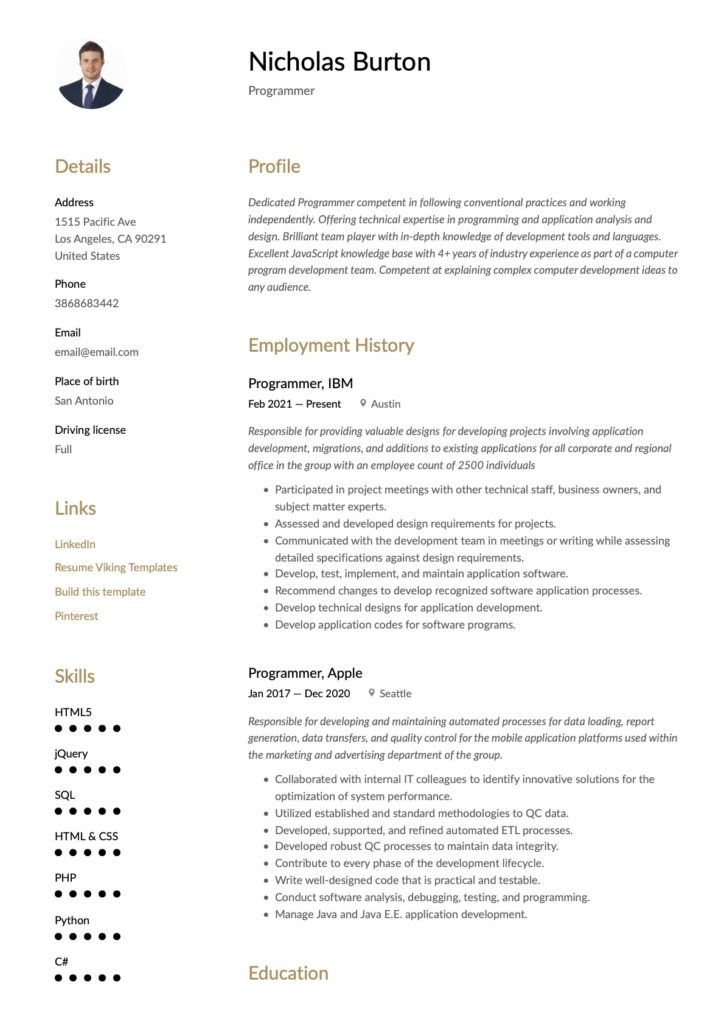
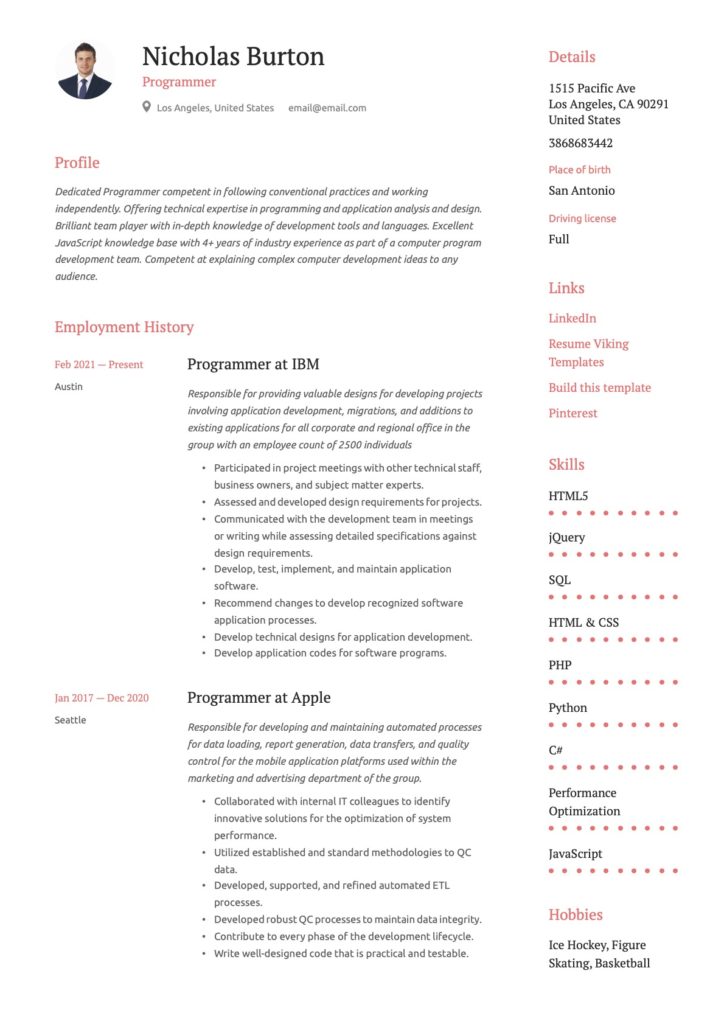
Professional information on Programmers
Sectors: Various
Career Type: Development, Coding, Information Technology, Computer Science, Engineering, Programming, Architecture, Networks
Person type: Writer, Debugger, Coder, Creator, Implementer, Designer, Developer, Facilitator, Fixer
Education levels: From Bachelor’s Degree upwards
Salary indication: From $48 373 (Indeed)
Labor market: Between 10% and 21% from 2018 to 2028 (BLS)
Organizations: All
